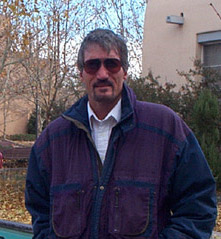Leslie D. McFadden
Professor Emeritus

- Education:
- Ph.D., University of Arizona, 1982
- Email:
- lmcfadnm@unm.edu
Research and Academic Interests:
Research emphasis on soil-geomorphic, soil-stratigraphic and soil-forming processes and more genrerally the critical zone in arid and semi-arid regions. Applications of soil-based research to problems in Quaternary studies and geomorphology, including landscape evolution and paleoclimate, numerical modeling studies of calcic soils, and analyses of seismic, volcanic and flood hazards. Current research also includes biogeomorphic studies and evaluation of impacts of late Quaternary climatic changes on landscapes of the southern Colorado Plateau.
Selected Recent Research Highlights
My colleagues, graduate students and I have been conducting a significant amount of research in an area on the Colorado Plateau in NE Arizona concerning the influences of Holocene climate change and grazing on the landscapes of this region (see McFadden and McAuliffe, 1997, Geomorphology; McAuliffe, Scuderi and McFadden, 2006, Global and Planetary Change), eolian processes, rates and processes of soil formation and rock weathering, and timing and impacts of draughts, and landscape ecology. Using a variety of dendrologic, dendroclimatic and dendrogeomorphic techniques (with Dr. Joe McAuliffe, Phoenix Desert Botanical Garden) we are looking at decadal and century scale erosion rates over the past few centuries (see 2005 Geological Society of America Abstracts with Programs, V. 37(7), p. 232).
My recent graduate student, Dr. Martha (Missy) Eppes, Dr. Alan Gillespie (University of Washington) and I have been conducting studies concerning the influence of the sun and the solar path on physical weathering of rocks in dryland regions (see McFadden et al., 2005, Geological Society of America Bulletin). Many surface rocks in the deserts of the Southwest exhibit vertical linear cracks that appear to represent the critical, first stage of weathering of these rocks into much smaller particles. Our studies suggest that differential thermal heating on a daily basis is the key to generating stresses that ultimately cause these fractures. This is most strongly demonstrated by the orientations of a statistically large number of these fractures that have a markedly north-south orientation, which we hypothesize reflects the sun induced east-west extension. The formation of these cracks appears to be a significant step that enhances the impacts of salt weathering and other types of weathering, that, in favorable circumstances, leads to the formation of angular, well sorted pavements.
Dr. Martha Eppes and I studied soils on alluvial fan and terrace deposits along the northern flank of the San Bernardino Mountains. One of the results of these studies showed that the type of soils that form on these surfaces is strongly influenced by deposit composition, and that with time, the varying rates and types of soil-forming processes has an increasing larger effect on the evolution of tectonic landforms (blind thrust-fault cored folds) observed in this region (see Fig. 4 in Eppes et al., 2002, Geology).
Recent Publications:
- The vesicular layer and carbonate collars of desert soils and pavements: formation, age and relation to climate change; Leslie D. McFadden, Eric V. McDonald, Stephen G. Wells, Kirk Anderson, Jay Quade, Steven L. Forman, Geomorphology, v. 24(2-3), p. 101-145, 1998.
- Influence of Parent Material and Grain Size On Carbonate Formation in Gravelly Soils in a Desert Piedmont, Sevilleta LTER, Palo Duro Canyon, New Mexico; Treadwell-Steitz, C. and McFadden, L.D. , Geoderma, v. 94, 1-22, 2000.
- Influence of soil development on the geomorphic evolution of landscapes: An example from the Transverse Ranges of California; Eppes, M.C., McFadden, L.D., Matti, J., and Powell, R., Geology, 2002; v. 30; no. 3; 195-198.
- The soil survey and soil geomorphology; Vance T. Holliday, Leslie D. McFadden, E. Arthur Bettis, and Peter W. Birkeland, in Douglas Helms (ed), History of the National Cooperative Soil Survey, Iowa State University Press, 2001.
- Soil inorganic carbon modeling; McFadden, L.D. and Amundson, R., Encyclopedia of Soil Science, New York, NY, Marcel Dekker, Inc.. 2002.
- Regional response of alluvial fans to the Pleistocene-Holocene climatic transition, Mojave Desert, California; McDonald, E.V., McFadden, L.D., and Wells, S.G., in Paleoenvironments and Paleohydrology of the Mojave and Southern Great Basin Deserts, Enzel, Y., Wells, S, and Lancaster, N. (eds), Geological Society of America Special Paper 368, p. 189-20, 2003.
- Physical weathering in landscapes due to variation in the direction of solar heating; McFadden, L., Eppes, M., Gillespie, A. and Hallet, B. Geological Society of America Bulletin; v. 117, p. 161-173, 2005.
- Tree-ring record of hillslope erosion and valley floor dynamics: landscape responses to climate during the last 400 years in the Colorado Plateau, northeastern Arizona; McAuliffe, J., Scuderi, L, and McFadden, L., Global and Planetary Change, v. 50, , p.184-20 , 2006.
